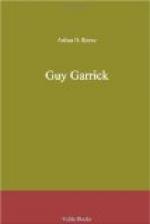He was busily engaged restoring everything in the room as far as possible to its former position.
“My scheme,” he went on, “is for us now to leave the apartment ostentatiously. I think that is calculated to insure the burglary, for they must have someone watching by this time. Then we can get back to that empty apartment in the house on the next street, and before they can get around to start anything, we shall be prepared for them.”
Garrick stopped to speak to the hall-boy again as we left, carrying the other box. What he said I did not hear but the boy nodded intelligently.
After a turn down the street, a ride in a surface car for a few blocks and back again, he was satisfied that no one was following us and we made our way into the vacant apartment on Seventy-third Street, without being observed.
Picking up the wires from the back yard of Warrington’s and running them across the back fence where he attached them to other wires dropped down from the vacant apartment was accomplished easily, but it all took time, and time was precious, just now.
In the darkness of the vacant room he uncovered and adjusted the other box, connected one set of wires to those we had led in and another set to an apparatus which looked precisely like the receiver of a wireless telegraph, fitting over the head with an earpiece. He placed the earpiece in position and began regulating the mechanism of the queer looking box.
“I didn’t want to use the detectaphone again,” he explained as he worked, “because we haven’t any assurance that they’ll talk, or, if they do, that it will be worth while to listen. Besides, there may be only one of them.”
“Then what is this?” I asked.
“Well,” he argued, “they certainly can’t work without light of some kind, can they?”
I acquiesced.
“This is an instrument which literally makes light audible,” he pursued.
“Hear light?” I repeated, in amazement.
“Exactly,” he reiterated. “You’ve said it. It was invented to assist the blind, but I think I’ll be able to show that it can be used to assist justice—which is blind sometimes, they say. It is the optophone.”
He paused to adjust the thing more accurately and I looked at it with an added respect.
“It was invented,” he resumed, “by Professor Fournier d’Albe, a lecturer on physics at the University of Birmingham, England, and has been shown before many learned societies over there.”
“You mean it enables the blind to see by hearing?” I asked.
“That’s it,” he nodded. “It actually enables the blind to locate many things, purely by the light reflected by them. Its action is based on the peculiar property of selenium, which, you probably know, changes its electrical conductivity under the influence of light. Selenium in the dark is a poor conductor of electricity; in the light it, strange to say, becomes a good conductor. Variations of light can thus be transmuted into variations of sound. That pushed-in end of the box which we hid over in Warrington’s had, as you might have noticed, a selenium plate on the inside partition, facing the open end of the box.”




